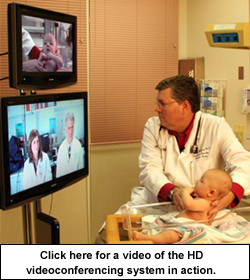 Without ever leaving the nursery, fragile babies born at Chillicothe’s Adena Regional Medical Center are receiving clinical assessments from specialists an hour away at Nationwide Children’s Hospital — thanks to high-definition videoconferencing capabilities made possible via the Ohio Supercomputer Center.
Without ever leaving the nursery, fragile babies born at Chillicothe’s Adena Regional Medical Center are receiving clinical assessments from specialists an hour away at Nationwide Children’s Hospital — thanks to high-definition videoconferencing capabilities made possible via the Ohio Supercomputer Center.
An example of telemedicine, the project enables specialists in Columbus to view distressed newborns with exceptional clarity, examine detailed x-rays, view lab results and consult with attending physicians in Chillicothe in real-time.
“Telemedicine dramatically increases the care of our youngest patients,” said Dr. John Fortney, medical director for Adena Health System. “If we’re looking for help with a diagnosis, someone from Children’s — whether it’s a neonatologist or a sub-specialist, such as a pediatric cardiologist — will see the patient and speak to the attending physician in real time.
“Currently, information is relayed by telephone, which means it’s subject to interpretation,” he said. “With high-definition videoconferencing, specialists can make a more thorough evaluation.”
Adena Regional Medical Center was selected for the pilot because the hospital sends more pediatric patients to Nationwide Children’s than any other outside of the Columbus metropolitan area. In their first year of operation with telemedicine, physicians were able to make quicker and more accurate clinical assessments via videoconferencing, especially regarding the need to transfer these critical care newborns.
“If a baby needs to be moved to our facility, doctors have seen the child, reviewed their diagnostic images and can prepare for the infant’s care as soon as he or she arrives,” said Dr. Stephen Welty, chief of neonatology, Nationwide Children's Hospital. “Just as importantly, we also use this as a tool to determine if a baby doesn’t need to be transferred. Then, the child can stay with family and avoid unnecessary stress.”
Telemedicine is a growing trend. Recently, the Federal Communications Commission’s Rural Health Care Pilot Program awarded $417 million to 69 projects around the nation to “significantly increase access to acute, primary and preventative health care in rural America.” Three of those projects serve Ohioans by providing high-speed connections to healthcare facilities in nearly half of Ohio’s 88 counties.
These three regional telehealth networks will connect to Broadband Ohio’s backbone to transport data traffic between regions in Ohio, as well as to use OSCnet to access Internet2, the primary national research and education network in the country. This fulfills a key requirement of the grant – that the healthcare traffic be able to flow across the country from Ohio.
“Just as OSCnet provides the higher education community with a backbone that allows it to share critical education material around the state of Ohio, it will provide a network infrastructure to help make the Governor’s Broadband Ohio initiative a reality for state-supported hospitals to access advanced telemedicine applications,” said Stan Ahalt, executive director of the Ohio Supercomputer Center.
Governor Strickland issued an executive order in July that created the Broadband Ohio Network by pairing OSCnet – the nation’s leading high-speed, statewide network dedicated to education, research and economic competitiveness – with the NextGen Network, a new state and local government system being developed by acquiring available bandwidth from OSCnet.
The order also created the Ohio Broadband Council to serve as the coordinating body for Broadband Ohio and to provide oversight of the initiative from a policy, procedure, process and development standpoint. Ohio’s Office of Information Technology manages the NextGen Network, while the Ohio Supercomputer Center continues to manage OSCnet.
|
Click on the images for a larger view.
|
||
Editor’s note: High resolution photos are available for download at www.osc.edu/press/logos/index.shtml.
Adena Health System is an independent, not-for-profit and locally controlled organization serving the needs of 10 counties in south central Ohio and employing more than 2,000 people. Adena’s vision is to be the best healthcare system in the nation through innovation and a customer centered philosophy. The system’s family of facilities includes Adena Regional Medical Center, Greenfield Area Medical Center, Adena Health Centers in Chillicothe, Jackson and Waverly. Adena’s Centers of Excellence include the Heart Center at Adena; the Center for Cancer Care; the Center for Women & Children; and Orthopedics/Neurology and Pain Management. Adena was founded in 1895 by area churches as the Chillicothe Hospital.
Ranked in the top 12 on U.S. News & World Report’s 2007 list of “America’s Best Children’s Hospitals,” Nationwide Children’s Hospital is one of the nation’s largest pediatric healthcare networks providing wellness, preventive, diagnostic, treatment and rehabilitative care for infants, children, adolescents and adult patients with congenital disease. A medical staff of nearly 900 and a hospital staff of 6,000 provide state-of-the-art pediatric care for more than 700,000 patient visits annually. As home to the Department of Pediatrics of The Ohio State University College of Medicine, Nationwide Children’s Hospital physicians train the next generation of pediatricians and pediatric specialists. The Research Institute at Nationwide Children's Hospital is one of the top 10 National Institutes of Health-funded free-standing pediatric research facilities. More information is available by calling (614) 722-KIDS (5437) or through www.NationwideChildrens.org.
Celebrating 20 years of service, the Ohio Supercomputer Center (OSC) is a catalytic partner of Ohio universities and industries that provides a reliable high performance computing and high performance networking infrastructure for a diverse statewide/regional community including education, academic research, industry, and state government. OSC promotes and stimulates computational research and education in order to act as a key enabler for the state's aspirations in advanced technology, information systems, and advanced industries. For additional information, visit http://www.osc.edu.
Contacts:
- Pam Barber, Director, Media Relations, Nationwide Children’s, 614-355-0495, pam.barber@nationwidechildrens.org
- Jennifer Dovyak, Public Relations Specialist, Adena Health System, 740-779-8551, jdovyak@adena.org
- Susan Mantey, Media Relations Specialist, Ohio Supercomputer Center, 614-688-3949, susan@osc.edu


